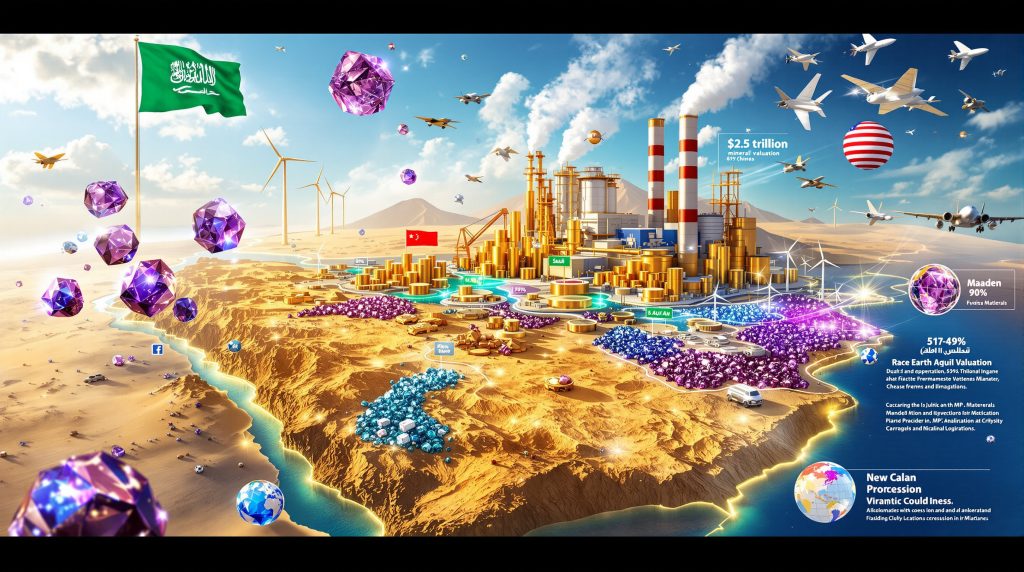Strategic Diversification in Critical Mineral Supply Chains
The global rare earth market faces unprecedented transformation as nations seek alternatives to concentrated processing capabilities. The Saudi rare earth venture represents a pivotal development in this evolving landscape, where countries with substantial mineral reserves are reshaping international market dynamics through strategic partnerships and processing facility development.
Current supply chain vulnerabilities stem from decades of processing consolidation in specific geographic regions. China controls approximately 85-90% of global rare earth processing capacity, according to the U.S. Geological Survey, creating systemic risks for technology manufacturers worldwide. Furthermore, China export controls have demonstrated how concentrated supply chains can impact global markets.
The Scale of Global Rare Earth Dependencies
Rare earth elements encompass seventeen metallic elements crucial for high-tech manufacturing. These materials enable permanent magnet production, battery technologies, and defense systems across multiple industries.
Key applications include:
• Electric vehicle motor manufacturing requiring neodymium and dysprosium
• Wind turbine generators utilising permanent magnet technology
• Military guidance systems and advanced radar equipment
• Smartphone and computer component production
The International Energy Agency projects massive demand increases for critical minerals through 2030, driven by clean energy transitions and technological advancement. Moreover, critical minerals energy security has become a paramount concern for nations worldwide.
Processing Capacity Concentration Risks
Geographic concentration in rare earth processing creates multiple vulnerability points for global supply chains. However, recent developments like the Saudi rare earth venture offer promising alternatives to traditional supply routes.
Supply disruption scenarios include:
• Geopolitical tensions affecting trade relationships
• Natural disasters impacting processing facilities
• Export restriction policies during international disputes
• Price manipulation through supply constraints
Historical examples demonstrate these risks vividly. Price volatility in rare earth markets has exceeded 400% during periods of restricted supply access. Consequently, trade wars and supply chains have highlighted the urgent need for supply diversification.
What Are the Strategic Advantages of Alternative Processing Hubs?
Nations with substantial mineral reserves increasingly pursue vertical integration strategies, developing domestic processing capabilities rather than exporting raw materials. This approach captures higher value-added production stages whilst reducing dependency on external processors.
Strategic advantages include:
• Enhanced supply chain control for domestic industries
• Increased export revenues through processed materials
• Technology sector development opportunities
• Geopolitical leverage in international negotiations
Electric Vehicle Manufacturing Dependencies
The electric vehicle sector represents the fastest-growing demand segment for rare earth elements. Permanent magnet motors in electric vehicles require specific rare earth combinations for optimal performance characteristics.
| Element | Application | Demand Growth Projection |
|---|---|---|
| Neodymium | Motor magnets | 300% by 2030 |
| Dysprosium | High-temperature applications | 250% by 2030 |
| Praseodymium | Motor efficiency enhancement | 275% by 2030 |
Automotive manufacturers actively seek supply chain diversification to reduce dependency risks and ensure consistent material access for production scaling. In addition, the Saudi exploration licenses initiative supports broader mineral development across the region.
Renewable Energy Infrastructure Requirements
Wind turbine manufacturing depends heavily on rare earth permanent magnets for generator efficiency. Offshore wind projects particularly require high-performance materials capable of withstanding harsh environmental conditions.
Solar panel manufacturing utilises rare earth elements in inverter systems and energy storage components. Grid-scale energy storage systems incorporate these materials for power management and conversion efficiency.
Renewable energy rare earth consumption:
• Wind turbines: 200-600 kg per MW capacity
• Solar installations: 50-100 kg per MW capacity
• Grid storage systems: Variable based on technology type
How Does the Saudi Rare Earth Venture Impact Defense Applications?
Military equipment manufacturers face particular supply security concerns due to national security implications. Defense applications require consistent access to high-purity rare earth materials for:
• Missile guidance system components
• Advanced radar array manufacturing
• Satellite communication equipment
• Electronic warfare systems
The U.S. Department of Defense has identified rare earth supply security as a critical national security priority, leading to increased investment in domestic processing capabilities. Furthermore, according to CSIS analysis, this new era of US-Saudi minerals cooperation strengthens strategic partnerships.
Market Dynamics and Pricing Implications
Current rare earth pricing reflects supply concentration risks and demand growth projections. Market participants increasingly focus on supply chain transparency and alternative source development.
Investment patterns show significant capital allocation toward alternative processing facilities and exploration projects outside traditional supply regions. For instance, the European critical materials facility represents another strategic diversification effort.
"Supply chain diversification efforts could reduce price volatility while ensuring consistent material access for technology manufacturers across multiple sectors," according to industry analysts monitoring the Saudi rare earth venture developments.
What Are the Technical Processing Challenges?
Rare earth separation and purification require sophisticated chemical processing capabilities. Environmental considerations include waste management, water treatment, and regulatory compliance across different jurisdictions.
Processing complexity factors:
• Multi-stage chemical separation requirements
• High-purity specifications for technology applications
• Waste stream management and environmental protection
• Skilled workforce development for specialised operations
Investment Opportunities and Strategic Partnerships
Critical minerals represent emerging investment opportunities as supply chain diversification accelerates. Market participants evaluate projects based on processing capacity, environmental standards, and strategic positioning.
Recent reports indicate that MP Materials shares have soared following the announcement of strategic partnerships in the region. Companies with established mining operations and processing capabilities benefit from increased demand for alternative supply sources.
Technology transfer partnerships enable rapid capability development in regions with substantial mineral reserves. Moreover, the Saudi rare earth venture demonstrates how strategic collaborations can reshape global supply chains.
Future Implications for Global Technology Supply Chains
Long-term supply chain resilience depends on geographic diversification and processing capacity development. Alternative supply sources reduce systemic risks whilst supporting continued technological advancement across multiple industries.
International cooperation frameworks for critical mineral security continue evolving as nations recognise mutual benefits from diversified supply chains and reduced single-source dependencies. However, the success of ventures like the Saudi rare earth venture will ultimately determine the pace of this transformation.
The development of alternative processing hubs represents a fundamental shift in global mineral supply dynamics, offering both opportunities and challenges for established market players and emerging economies alike.
This analysis is based on publicly available information and industry reports. Investment decisions should consider multiple factors including market conditions, regulatory environments, and individual risk tolerance. No investment advice is provided.
Looking to Capitalise on Critical Minerals Market Opportunities?
Discovery Alert provides instant notifications on significant ASX mineral discoveries across rare earth elements and critical minerals, powered by its proprietary Discovery IQ model. With supply chain diversification creating unprecedented opportunities in the sector, subscribers receive rapid insights into actionable trading opportunities, positioning themselves ahead of broader market movements through real-time discovery alerts.




